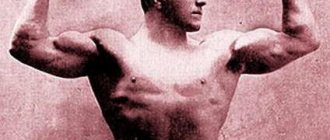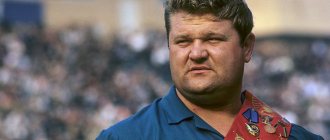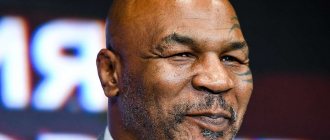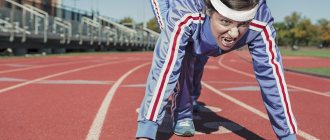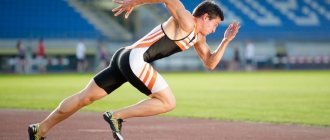Marathons are not uncommon among a large number of sports competitions. Both professional and experienced athletes, as well as amateur athletes, take part in them. How did the marathon distance appear and how many days in a row can you complete it?
What is the history of the marathon, which is over 42 kilometers long, and what are the current marathon world records for women and men? Who are the top ten fastest marathon runners and what are some interesting facts about the 42km marathon? Read this article for tips on preparing for and completing a marathon.
History of the 42-kilometer marathon
The marathon is an Olympic track and field discipline and the length of the marathon is 42 kilometers, 195 meters (or 26 miles, 395 yards). Men have competed in this discipline at the Olympic Games since 1896, and women since 1984.
As a rule, marathons are held on the highway, although sometimes this word means competitions in running over long distances over rough terrain, as well as in extreme conditions (sometimes the distances can be different). Another popular running distance is the half marathon.
Antiquity
As the legend goes, Pheidippides, a warrior from Greece, in 490 BC, after the end of the Battle of Marathon, ran non-stop to Athens in order to notify his fellow tribesmen of the victory.
When he reached Athens, he fell dead, but still managed to shout: “Rejoice, Athenians, we have won!” This legend was first described by Plutarch in his work “The Glory of Athens,” more than half a millennium after the actual events.
According to another version (Herodotus tells about it), Pheidippides was a messenger. He was sent by the Athenians to the Spartans for reinforcements, and ran more than 230 kilometers in two days. However, his marathon was unsuccessful...
Nowadays
Frenchman Michel Breal came up with the idea of organizing a marathon race. He dreamed that this distance would be included in the program of the Olympic Games in 1896 in Athens - the first in modern times. The Frenchman's idea was liked by Pierre de Coubertin, who was the founder of the modern Olympic Games.
The first qualifying marathon was eventually held in Greece, with the winner being Charilaos Vasilakos, who completed the distance in three hours and eighteen minutes. And the Greek Spyridon Louis became the Olympic champion, completing the marathon distance in two hours, fifty-eight minutes and fifty seconds. Interestingly, on the way he stopped to have a glass of wine with his uncle.
Women's participation in the marathon during the Olympic Games took place for the first time at the games in Los Angeles (USA) - this was in 1984.
Marathon distance
At the first Olympic Games in 1896, the length of the marathon was forty kilometers (24.85 miles). Then it changed, and since 1924 it became 42.195 kilometers (26.22 miles) - this was established by the International Amateur Athletics Federation (the modern IAAF).
Olympic discipline
The men's marathon has been the final track and field program since the first modern Olympic Games. Marathon runners finished at the main Olympic stadium, either a few hours before the closing of the games, or at the same time as the closing.
Myth #1, the most important: running kills your knees
Many people - even some doctors - are against running as a form of regular exercise. Their argument: Running is hard on your knees. The ligaments that support the knee joint wear out, and the joint itself becomes inflamed and worn out. Is it true?
Short.
This is truly a myth.
Read more.
Running with normal technique and without extreme loads is no more traumatic for the knees than any other sport, says Ph.D. in athletics Evgeny Kalinin. In the past, he worked as the head of the analytical management department at the Sports Training Center for National Team Athletes - and has written more than 40 scientific papers, many of which are devoted to the training of runners. Where then do the stories about injuries come from? Kalinin argues that problems arise in two cases: due to incorrect running technique and due to attempts to “overcome oneself,” when a person continues to run despite severe pain.
“I observed various technical violations,” explains the expert. “Some run on their toes, while others, on the contrary, fall on their heels, and even fully straighten their leg at the knee. Often people seem to “rake” with their legs - although if you look at professional runners, you will see that they move their legs like a needle in a sewing machine: straight, up and down, perpendicular to the ground.”
Kalinin advises amateur runners to watch a video that explains the correct running technique (video example). Another option is to take a couple of lessons with a professional trainer. But most importantly, he recommends starting to run slowly, monitoring the discomfort in the body and stopping as soon as the workout ceases to be enjoyable. Another piece of advice for beginners: at least at first, do not run while listening to music - it interferes with concentrating on bodily sensations.
However, your knees can really hurt from running.
. Neurologist-vertebrologist, manual therapy doctor for the CSKA hockey club Vladimir Demchenko explains that knee pain is divided into adaptive and pathological. “Normal pain in the knees as a reaction to stress is bilateral, diffuse and not localized to a specific point, lasting no more than a day. If the pain is acute, in a specific place, especially if the knee swells and it doesn’t go away for more than a day, this is a reason to see a doctor,” says Demchenko. To protect yourself from injury, he advises doing a warm-up before running and a cool-down after. Joint gymnastics is good for this. And if your knees still hurt, you can apply ice to them immediately after training.
So, pain and injury can be avoided if you run correctly. But a skeptic would likely say that running doesn't bode well for your knees in the long run.
In fact, there is no scientific basis for this statement. Scientists from the UK conducted a meta-analysis of studies examining the relationship between knee injuries and running five years ago. They found that there was probably no link between running and knee osteoarthritis, a condition that causes inflammation of the knee joints, chronic pain and limited mobility. And, moreover, regular running can even prevent knee surgery.
The authors of a meta-analysis that studied the effect of running on the condition of the ligamentous apparatus of the knee joint came to approximately the same conclusions. They noted that, in general, the ligaments of runners and non-runners were not particularly different. And in the long term, even if running has an effect on the ligaments, it is rather positive - due to the fact that it increases their nutrition due to blood flow, helps remove excess fluid and strengthens the leg muscles, which reduces the load on the knee apparatus.
Current world records
In men
The world record for men's marathon running belongs to Kenyan athlete Dennis Kimetto.
He ran a distance of 42 kilometers and 195 meters in two hours, two minutes and fifty seconds. This was in 2014.
Among women
The world record in the women's marathon belongs to British athlete Paula Radcliffe. In 2003, she ran the marathon in two hours, fifteen minutes and twenty-five seconds.
In 2012, Kenyan runner Mary Keitany tried to break this record, but she failed. She ran the marathon slower than Paula Radcliffe by more than three minutes.
How to Run 10K: Key Points
Preparing for a 10 km run involves, first of all, developing endurance. Each person has his own physical limit, defined as the norm of reaction. You can improve your results up to this limit. Running 10 km is precisely a step towards that same maximum norm. If it comes easy to you, you can limit the time for this (for example, 52 minutes). If you have endured the reduced time, reduce it further, and reduce it to the point where you simply cannot keep up with the time.
To improve your results in running, you need to know such basics as proper technique, warm-up, breathing, and others.
An important point is the psychological mood. 10 km may initially seem like an insurmountable obstacle. It is important to prepare for this both physically and mentally. Tune in. Think about the distance and its possible paths, and also, which is very important, realize that you need it.
The first third of the distance you can run vigorously, the second - you are quite tired, but in the third the body may stubbornly want to stop. It is important to ignore this urge and run further - it is in this moment of overcoming that you train your brain as much as possible. Psychological endurance is a very important point in running, especially when it comes to long distances.
A very important point in learning to run 10 km is the development of breathing. You need to breathe correctly, be sure to inhale through your nose, smoothly and measuredly. In the last stages of running, when it will be difficult to breathe, the lungs are powerfully strengthened.
When running long distances, you may feel an unpleasant tingling sensation in your left or right side, which makes you want to stop. This moment is called the “dead point”. It is important to overcome it, first of all, psychologically. Set yourself a pace and speed up your arm movements, moving your body forward. Take two steps for inhalation, and two steps for exhalation.
An important point is comfortable clothing that should not restrict movement. Be sure to tie your shoelaces well - it is important not to stop while running so as not to lose your breath. It's better to run without music to focus on your breathing and distance.
The choice of route is also important. Avoid roads with traffic lights, as this will force you to make unwanted stops. Let the road be smooth, without holes.
If you manage to properly prepare for a 10K run, both mentally and physically, you will probably be able to overcome this distance, although it may not be easy if you are not used to it.
Top ten fastest male marathon runners
The favorites here are mainly athletes from Kenya, as well as Ethiopia.
- runner Dennis Kimetto . He ran the Berlin Marathon on September 28, 2014 in 2 hours, 2 minutes and 57 seconds.
- runner Kenenisa Bekele. He ran the Berlin Marathon on 25 September 2016 in 2 hours 3 minutes 3 seconds.
- Kenyan runner Eliud Kipchoge ran the London Marathon on April 24, 2016 in 2 hours, 3 minutes and 5 seconds.
- Kenyan runner Emmanuel Mutai ran the Berlin Marathon on September 28, 2014 in 2 hours, 3 minutes and 13 seconds.
- Kenyan runner Wilson Kipsang ran the Berlin Marathon on September 29, 2013 in 2 hours, 3 minutes and 23 seconds.
- Kenyan runner Patrick Makau ran the Berlin Marathon on September 25, 2011 in 2 hours, 3 minutes and 38 seconds.
- Kenyan runner Stanley Biwott ran the London Marathon on April 24, 2016 in 2 hours, 3 minutes and 51 seconds.
- An Ethiopian runner completed the Berlin Marathon on September 28, 2008 in 2 hours, 3 minutes and 59 seconds.
- Kenyan runner Elihu DKipchoge completed the Berlin Marathon in 2 hours, 4 minutes on September 27, 2015.
- The top ten is completed by Kenyan runner Geoffrey Mutai, who completed the Berlin Marathon on September 30, 2012 in 2 hours, 4 minutes and 15 seconds.
Myth #5: running in the city is harmful - the air is very dirty
Someone may think that if you do not live outside the city or at least next to a large park, then it is better not to run on the streets - the harm from inhaling polluted air will be greater than the benefit from jogging. Is it so?
Short.
This is probably a myth.
Read more.
So far, scientists do not have much data on how jogging in a modern city affects health in the long term. More recently, researchers from the Czech Republic began such observations, but they will be able to draw conclusions only after several - or even several decades - years.
But in 2016, a study was published that looked at cyclists and tried to understand whether the benefits of physical activity outweighed the negative effects of air pollution. It turned out that yes, they outweigh.
With running, it's probably the same - the positive effect of the load on the cardiovascular system and lungs most likely compensates for the damage from bad air. And in this sense, it is better to run through the streets in the city than not to run at all. And if you choose parks or at least not the widest avenues for jogging, then this is absolutely wonderful.
Top ten fastest female marathon runners
- In 2 hours 15 minutes and 25 seconds, British athlete Paula Radcliffe ran the London Marathon on April 13, 2003.
- In 2 hours 18 minutes and 37 seconds, Kenyan runner Mary Keitany ran the London Marathon on April 22, 2012.
- In 2 hours 18 minutes and 47 seconds, Kenyan runner Catherine Ndereba ran the Chicago Marathon on October 7, 2001.
- In 2 hours 18 minutes 58 seconds, Ethiopian Tiki Gelana completed the Rotterdam Marathon on April 15, 2012.
- In 2 hours 19 minutes 12 seconds, Japanese Mizuki Noguchi ran the Berlin Marathon on September 25, 2005.
- In 2 hours 19 minutes 19 seconds, an athlete from Germany Irina Mikitenko ran the Berlin Marathon on September 28, 2008.
- In 2 hours 19 minutes 25 seconds, Kenyan Gladys Cherono completed the Berlin Marathon on September 27, 2015.
- In 2 hours 19 minutes 31 seconds, Ethiopian runner Aselefesh Mergia ran the Dubai Marathon on January 27, 2012.
- In 2 hours 19 minutes and 34 seconds, Kenyan runner Lucy Kabuu completed the Dubai Marathon on January 27, 2012.
- Rounding out the top ten female marathoners is Dina Kastor from the United States, who ran the London Marathon in 2:19.36 on April 23, 2006.
Interesting about the 42-kilometer marathon
- Overcoming a running distance of 42 kilometers 195 meters is the third stage in the Ironman triathlon competition.
- The marathon distance can be covered both during competitive and amateur races.
- So, in 2003, Ranulph Fiennes from Great Britain ran seven marathons over seven days on seven different continents and parts of the world.
- Belgian national Stephaan Engels decided in 2010 that he would run a marathon every day of the year, but he was injured in January, so he started all over again in February.
- On March 30, the Belgian beat the result of the Spaniard Ricardo Abad Martinez, who ran 150 marathons in the same number of days in 2009. As a result, by February 2011, within a year, 49-year-old Stefan Engels completed the 365th marathon. On average, he spent four hours on the marathon and achieved a best result of two hours and 56 minutes.
- Johnny Kelly took part in the Boston Marathon more than sixty times from 1928 to 1992, and eventually reached the finish line 58 times and won twice (in 1935 and 1945).
- On December 31, 2010, 55-year-old Canadian citizen Martin Parnell ran 250 marathons during the year. During this time, he wore out 25 pairs of sneakers. Also, at times he had to run in temperatures below minus thirty degrees.
- According to scientists from Spain, the bones of marathon runners for a long time in old age do not undergo aging and destruction, unlike other people.
- Russian runner Sergei Burlakov, who has both legs and hands amputated, competed in the New York City Marathon in 2003. He became the world's first marathon runner with a quadruple amputation.
- Indian citizen Fauja Singh became the world's oldest marathon runner. He entered the Guinness Book of Records when he ran the marathon at the age of 100 in 8:11:06 in 2011. Now the athlete is over a hundred years old.
- Australian farmer Cliff Young won the ultramarathon in 1961, despite the fact that he participated in it for the first time. The runner covered 875 km in five days, fifteen hours and four minutes. He moved at a slow pace, at first falling far behind the others, but eventually leaving the professional athletes behind. He succeeded in this because he moved without sleep (this became his habit, since as a farmer he worked for several days in a row - collecting sheep in the pastures).
- British runner Steve Chalk has raised the largest charity donation in marathon history, two million pounds. This happened during the London Marathon in April 2011.
- Brian Price, 44, took part in the marathon less than a year after he underwent a heart transplant.
- Swedish radio operator Andree Kelberg completed a marathon distance while moving along the deck of the ship Sotello. In total, he ran 224 laps around the ship, taking four hours and four minutes.
- American runner Margaret Hagerty took up running at the age of 72. By the age of 81, she had already participated in marathons on all seven continents of the world.
- British runner Lloyd Scott completed the London Marathon in 202 wearing a diver's suit weighing 55 kilograms. He spent about five days doing this, setting a world record for the slowest marathon run. In 2011, he took part in the marathon dressed as a snail, spending 26 days in the race.
- Ethiopian athlete Abebe Bakila won the Rome Marathon in 1960. Interestingly, he covered the entire distance barefoot.
- As a rule, a professional marathon runner runs a marathon at a speed of 20 km/h, which is twice as fast as the migration of reindeer and saigas.
Myth #2: Running is bad for your spine
In addition to knee concerns, when people talk about running, they often worry about the health of their spine. What if regular jogging will harm him, and this will cause or worsen back pain?
Short.
This is also a myth.
Read more.
Evgeny Kalinin explains that the connection between running and back pain - mainly in the lower back - is approximately the same as with knee pain: it all depends on the technique. “When you get tired while jogging, you can start to sort of fall forward - this is especially common in overweight people who have large deposits of fat in the abdominal area. Or, conversely, a person may begin to “fall” backwards,” explains Kalinin. All this changes the curvature of the spine, especially in the lumbar area - the natural lordosis, which is needed for proper distribution of the load, is lost. Then, to compensate for changes in the shape of the spine, the surrounding muscles are activated - and the back may begin to hurt.
How to avoid such consequences? The coach, again, suggests carefully monitoring your condition while jogging. If you feel that you are tired of keeping your back straight and fall forward or backward, if you start to twist your pelvis or body too much, this means that your body is giving you a signal of fatigue. Stop, take a break - as soon as you feel strong again, you can run further.
Running is also not prohibited for overweight people - they just need to pay even more attention to the sensations in their body, perhaps take breaks more often and start walking.
Do any changes occur to the spine if you run for a long time and regularly? Tracking how running affects your back health over the years is not easy. This is because back pain is a very common problem in adults, and it may have nothing to do with physical activity.
But you can look at the results of studies where some people with existing pain in the spine were given the task of running - and looked at the effect. In two such experiments, participants ran quite intensely on a treadmill for 12 weeks - they had to achieve a heart rate of 85% of the maximum. The result is that their chronic lower back pain has decreased by an average of 30–40%.
Another possible way to assess the impact of running on spinal health is to study the spinal structures that commonly lead to pain in runners and non-runners. In 2017, researchers demonstrated for the first time that running can strengthen intervertebral discs: in runners, they are more hydrated and increased in size, especially in the lumbar region. And healthy intervertebral discs mean flexibility and mobility of the spine, protection from hernias and “pinching”, which can cause pain.
There is not yet enough scientific work studying the connection between running and back pain to draw clear conclusions. But the available data rather suggests that jogging will not harm the spine - on the contrary, it may even maintain its health.
Marathon running standards
For women
The rank standards for marathon running over a distance of 42 kilometers 195 meters for women are as follows:
- Master of Sports of International Class (MSMK) - 2:35.00;
- Master of Sports (MS) - 2:48.00;
- Candidate Master of Sports (CMS) - 3:00.00;
- 1st category – 3:12.00;
- 2nd category – 3:30.00;
- 3rd category - Zak.Dist.
For men
The rank standards for running a marathon with a distance of 42 kilometers 195 meters for men are as follows:
- Master of Sports of International Class (MSMK) - 2:13.30;
- Master of Sports (MS) - 2:20.00;
- Candidate Master of Sports (CMS) - 2:28.00;
- 1st category – 2:37.00;
- 2nd category – 2:48.00;
- 3rd category - Zak.Dist.
How to prepare for a marathon in order to run it in the minimum amount of time?
Training mode
The most important thing is regular training, which should begin at least three months before the competition.
If your goal is to run a marathon in three hours, then you need to run at least five hundred kilometers during training in the last month. It is advisable to train as follows: three days of training, one day of rest.
Vitamins and diet
The following must be consumed as vitamins and microelements:
- WITH,
- IN,
- multivitamins,
- calcium,
- magnesium.
You can also try the popular “protein” diet before the marathon, and a week before the competition, stop eating foods that contain carbohydrates. At the same time, three days before the marathon you need to exclude foods containing proteins and eat foods containing carbohydrates.
Equipment
- The main thing is to choose comfortable and lightweight sneakers, the so-called “marathon” ones.
- Places where friction may occur can be coated with petroleum jelly or baby oil.
- It is better to give preference to high-quality clothing made from synthetic materials.
- If the marathon takes place on a sunny day, a hat will be required, as well as a protective cream with a filter of at least 20-30.
Tips for participating in competitions
- Set a goal and clearly go towards it. For example, determine the time it will take you to cover the distance, as well as the average time.
- There is no need to start quickly - this is one of the common mistakes of all newbies. It is better to distribute your forces evenly.
- Remember: reaching the finish line is a worthy goal for a beginner.
- During the marathon itself, you should definitely drink - either clean water or energy drinks.
- Various fruits will help replenish your strength, such as apples, bananas or citrus fruits, as well as dried fruits and nuts. Energy bars will also come in handy.
Myth #3: You need expensive running shoes to run.
Lightweight, with a thin sole, with shock absorption, tread, mesh for ventilation... Are all these characteristics of running shoes that are advertised by sports shoe manufacturers really so important for maintaining health?
Short.
This is mostly a myth.
Read more.
There is not enough scientific evidence to confirm or refute the health benefits of dedicated running shoes (it may have implications for athletic performance, but that's another matter). Evgeny Kalinin notes that the main thing is that the sneakers are comfortable, do not rub or press on the leg, that is, do not interfere with the flow of blood.
In his opinion, the truly important indicator of a shoe is what surface it is made for. “Different surfaces - be it asphalt, a stadium, a running track or the ground in a park - have different degrees of shock absorption. If, for example, you run on asphalt, then it does not provide any shock absorption at all - then sneakers will come in handy, which compensate for this due to their shock-absorbing properties,” says Kalinin.
According to Kalinin, it also makes sense to pay attention to the individual structural features of the feet: flat feet, feet that fall inward, or slightly different leg lengths. “In this case, individually fitted shoes or orthotics can improve running performance and reduce the risk of injury,” explains the expert.
A large meta-analysis including 63 studies confirmed that running shoe design can
influence the biomechanics of running - and, accordingly, the risk of injury. But the authors of the analysis stressed that the existing data is not enough to give any specific advice on what exactly the “right” running shoes should be.
In another scientific paper, summarizing data from six meta-analyses, the authors came to the conclusion that there is no evidence that individual selection of running shoes - a service now often offered to beginning runners - has any evidence base. And using “minimalist” sneakers—running shoes that mimic the effect of “bare legs”—may even increase the risk of injury.
To summarize: you should approach the choice of running shoes carefully.
They should be comfortable, match your anatomical features and fit the surface on which you are working. It is not necessary to buy your first running shoes very expensive and with the latest technology. Do you need to buy running shoes from a specialty store?
This is generally also a myth. Shoes and other equipment for jogging can be purchased, for example, on Ozon. Here you can find more than 600 types of sneakers from leading brands, 300 items of running clothing. And also: sports watches and bracelets and a selection of books that will help you get involved in sports. Reminder's pick is Japanese writer and marathon regular Haruki Murakami's book What I Talk About When I Talk About Running. After reading it, it’s impossible not to fall in love with running.
